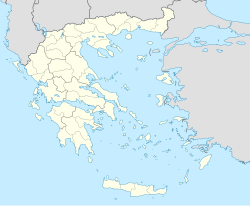The Church of Hagios Spyridon (Greek: Ιερός Ναός Αγίου Σπυρίδωνος) is a Greek Orthodox church in Rhodes, Greece. It is a medieval Byzantine church build in the thirteenth century within the old walled city of Rhodes.[1] During the Ottoman period of the island, it was converted into a mosque called Kavaklı Mescidi, before it was returned to Christian worship.
| Hagios Spyridon | |
|---|---|
| Άγιος Σπυρίδων | |
 | |
| 36°26′34″N 28°13′34″E / 36.44278°N 28.22611°E | |
| Location | Rhodes |
| Country | Greece |
| Language(s) | Greek |
| Denomination | Greek Orthodox |
| History | |
| Founded | 13th century |
| Dedication | Saint Spyridon |
| Architecture | |
| Functional status | Open |
| Architectural type | Byzantine architecture |
| Specifications | |
| Number of domes | 1 |
| Materials | Brick, stone, marble |
| Administration | |
| Metropolis | Metropolis of Rhodes |
History
editExcavations and restorations carried out in 1984 revealed that a first church was built on the ruins of a Hellenistic three-aisled building in the thirteenth century, but it is unclear who the church was dedicated to.[2][3][4] Hagios Spyridon in its current form was erected in the sixteenth century, on top of the previous one.[3] After the island fell to the Ottoman Turks in 1522, it was converted into a mosque,[3] called Kavakli Mosque after the Turkish word for poplar (kavak).[3]
It was in modern times that the 4th Ephorate of Byzantine Antiquities, during excavations, and by way of a process similar to the one adopted for the designation of the churches of Hagios Artemios and Hagia Kyriaki, decided to attribute Saint Spyridon to this church.[4]
Architecture
editThe first church building had a semicircular arch for the sanctuary and a floor with marble inlays and frescoes. The newer church of the sixteenth century preserved the arch and parts of the frescoes. From this period, new murals and a burial crypt with frescoes under the floor of the northern aisle are also preserved, which houses, among others, the tombs of the two founders of the church, who were father and son.[3]
Out of the various murals decorating the interior of Hagios Spyridon, the most distinguished one is the representation of Virgin Mary the Mother of God and Staint John (dating to the early sixteenth century), flanked by two male figures in a posture of prayer. The inscriptions next to their faces reveals their names: Andreas and Georgios, presumably the father and son who financed part of the decoration of the church and who were buried in the crypt.[4] After the Ottoman conversion to a mosque, the murals were covered and thus preserved to this day.[3]
After its conversion, a minaret was added on the northwest corner of Hagios Spyridon, which survives whole to this day.[3]
See also
editReferences
edit- ^ Gioles, Nikolaos; Palles, Georgios (2014). Άτλας των Χριστιανικών Μνημείων του Αιγαίου: Από τους Πρώτους Χριστιανικούς Χρόνους μέχρι την Άλωση [Atlas of the Christian Monuments of the Aegean: From the Early Christian Years Until the Fall of Constantinople] (in Greek). Athens. p. 408. ISBN 978-618-80577-4-6. Retrieved December 12, 2022.
{{cite book}}: CS1 maint: location missing publisher (link) - ^ Anastasiou, A.; Syrokou, E.; Tapinaki, S.; Georgopoulos, A. (2020). "Holistic 3D digital documentation of a byzantine church". The International Archives of the Photogrammetry, Remote Sensing and Spatial Information Sciences, Volume XLIII-B2-2020. XXIV ISPRS Congress. pp. 1363–1370.
- ^ a b c d e f g Άγιος Σπυρίδωνας (Καβακλί Τζαμί) [Hagios Spyridon (Kavakli Mosque)] (in Greek). Retrieved December 12, 2022.
{{cite book}}:|website=ignored (help) - ^ a b c Church of Agios Spyridon (St. Spyridon). Retrieved December 12, 2022.
{{cite book}}:|website=ignored (help)
External links
edit- Media related to Hagios Spyridon at Wikimedia Commons
